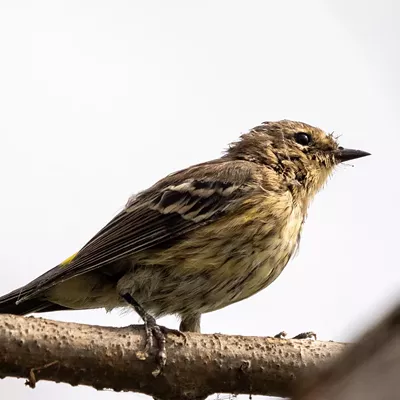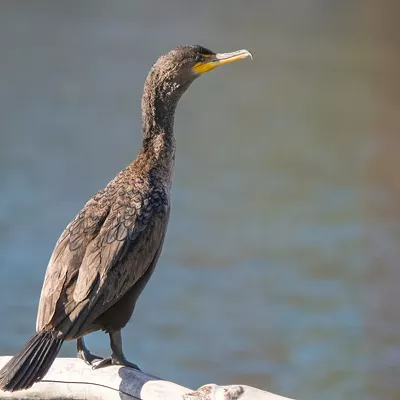How Michigan helped bald eagle populations rise from the brink of extinction
We were the first state to ban a pesticide that affected eagle’s ability to reproduce

Audio By Carbonatix
[
{
"name": "GPT - Leaderboard - Inline - Content",
"component": "35519556",
"insertPoint": "5th",
"startingPoint": "3",
"requiredCountToDisplay": "3",
"maxInsertions": 100,
"adList": [
{
"adPreset": "LeaderboardInline"
}
]
}
]

If you’ve done any hiking around Belle Isle in the past few years, you’ve likely seen the pair of bald eagles nesting on the island. This used to be a rare sight as these majestic birds were once on the brink of extinction, but they’ve since seen a comeback across the U.S. thanks, in part, to Michigan scientists.
The state led the charge on banning a pesticide called DDT that was decimating eagle eggs in 1969. The rest of the country followed suit in 1972.
The most recent statewide survey released by the Michigan Department of Natural Resources recorded 900 bald eagle breeding pairs in the state in 2019. In 2000, Michigan only had 359 pairs, and that number was as low as 83 in 1980.
The bald eagle population in the U.S. reached an all-time low of 417 nesting pairs across the lower 48 states in 1963, and the species was considered endangered. Luckily, researchers at the University of Michigan discovered that DDT, or dichloro-diphenyl-trichloroethane, was thinning eagle eggshells so badly they had almost no chance of survival.
“People would be out doing field work, and going up to look at field nests and they were finding omelets,” Oakland Audubon president Don Burlett tells Metro Times.
DDT was one of the first synthetic insecticides developed in the 1940s and was widely used across the country in crop and livestock production. It was also approved by the U.S. Department of Agriculture to combat insect-borne human diseases like malaria and typhus.
In the 1950s an ornithologist from Michigan State University named George Wallace discovered DDT was killing robins. At the time, the university was using the pesticide to kill beetles to stop the spread of Dutch elm disease, a fungal infection that decimated trees. Around the same time, former Michigan DNR Director Ralph MacMullin started a campaign to ban hard pesticides like DDT because he was seeing bioaccumulation in animals.
Interestingly enough, the link between DDT and eagles was initially spurred from discoveries of the pesticide in fish.
By the 1960s, the Michigan Department of Agriculture was finding high levels of DDT in salmon caught in the Great Lakes. Burlett says the FDA wound up impounding nearly 14 tons of salmon from Michigan because they were unsafe for human consumption.
In 1969, MSU researchers realized DDT was also affecting eagles after seeing those bird nest omelets Burlett mentioned.
“As DDT was in the environment, in the lakes and rivers, it gets in the fish or other animals — and the eagles eat those animals, so they accumulate DDT in their bodies,” says Chris Mensing, a biologist with the U.S. Fish and Wildlife Service. “They call it bioaccumulation, where it just moves all the way through the food web, and eagles are a pretty top-level predator.”
He adds, “With them having thin egg shells, just imagine a bird needing to have an eggshell to protect the chick — and as they sit on it to incubate the eggs, their reproduction was taking some pretty severe hits.”
Marine biologist and conservationist Rachel Carson’s book Silent Spring is credited with exposing the harms of pesticides and influencing the ultimate reversal in U.S. policies around DDT, but the book itself credits Wallace’s work at MSU.
Banning DDT wasn’t the only factor in saving the bald eagle, but it was a huge contributor to the species’ survival. Other issues like hunting and loss of habitat also affected bald eagle populations, but were mitigated by things like the Migratory Bird Treaty Act, the Bald and Golden Eagle Protection Act, and the Endangered Species Act.
“Those highlighted the issues and recognized the importance of maintaining healthy bird populations, which requires a healthy ecosystem,” Mensing says. “So it’s part of this larger understanding of human activity causing these issues.”
Eagles were deemed an endangered species in 1978, but were removed from the list in 2007 as their populations began to rise. Mensing says within the last 10 years Michigan has seen a drastic uptick in bald eagle sightings. The birds migrated to the Upper Peninsula in the 1950s to escape human disturbances, but Mensing says they have begun returning to urban areas in the Lower Peninsula, hence the sightings on Detroit’s Belle Isle.
“Lansing, just a handful of years ago, had our first nesting bald eagle in 100 years or something like that,” he says. “You’re seeing these eagles return back to a landscape where they had been completely extirpated from for decades, and it just shows that these eagles are showing a tolerance to being in a more active landscape, urban landscape.”
As for Belle Isle, Mensing says the Fish and Wildlife Service has recorded a nest on the island since 2018, likely from the same pair of eagles.
Though DDT has been banned and eagle populations are steadily rising, other hazards like “forever chemicals” called PFAS, lead poisoning, and even residual DDTs persist.
“You can still find levels of DDT in birds,” he says. “It’s still out there in the environment. Now, is it impacting them the way it used to? No, but contaminants like PCBs [polychlorinated biphenyls] that were used in manufacturing plastics also cause significant issues to eagle populations, especially in areas where manufacturing plants were using it more often like the Saginaw River and Kalamazoo River. We’re working with those areas to clean up and remove those contaminants.”
Mensing says regular people like us can do our part in keeping these raptors safe by giving them space. Also, slow down if you see one in the road, as they are relatively slow birds and many die from being hit by cars.
“Over in the Detroit area, in the Detroit River International Wildlife Refuge or other areas, you’re gonna see and hear eagles,” he says. “They definitely can handle people being around… but they still do need to be given some space, especially during nesting season when they’re busy trying to make sure that they’re incubating their eggs.”
He says if you happen upon a bald eagle nest, let the U.S. Fish and Wildlife Service or Michigan DNR know so they can add it to their database. If the nest is in a Metropark, notify the park staff so they can put appropriate protections around it.
“As long as they have a food source,” Mensing says, “the eagles can survive.”
Subscribe to Metro Times newsletters.
Follow us: Google News | NewsBreak | Reddit | Instagram | Facebook | Twitter













